Spectro-Chrome: Healing With Colored Light
- January 21, 2018 • 93,551 views
Story at-a-glance
- Chromotherapy can be used as a complementary treatment for virtually any disease or ailment, but is particularly effective for burns, chronic disorders and pain
- You can implement colored light therapy either by shining light through a colored filter, or by wearing colored glasses, so that the light striking your retina is of a particular color frequency
- Indigo and blue are used for “hot” conditions such as burns, inflammation and wounds; lemon, yellow and red are staples for chronic conditions; magenta benefits depression and purple is helpful for sleep disorders
30 Tips in 30 Days Designed to Help You Take Control of Your
Health
This article is part of the 30
Day Resolution Guide series. Each day a new tip will be added designed
to help you take control of your health. For a complete list of the tips
click HERE
Wouldn't it be wonderful to be able to use colors as a way to make your life healthier? The truth is, you can. Dr. Alexander Wunsch, who is based in Germany, is a world-class expert in the use of light as a therapeutic healing agent, and is a human treasure trove of information on a topic that very few people understand.
In previous interviews, we've discussed the history of photobiology and how LED lighting can compromise your health. Here, our focus in on the therapeutic use of colored light, which Wunsch began experimenting with nearly 25 years ago.
"My first approach was colorpuncture from Peter Mandel. One evening, I met a friend of mine. I told him I would like to go deeper into the colorpuncture issue and learn more about that. He handed me a book by Darius Dinshah, 'Let There Be Light: Practical Manual for Spectro-Chrome Therapy' …
I thought this is really a fascinating color system. It's not only a color therapy method, it's also a beautiful color system — [the way] Dinshah arranged these 12 basic colors, how they compose the Spectro-Chrome color wheel is a pleasure by itself, because it's very symmetric and there's a very logical plan behind it. I started to evaluate this method on my own."
Why Chromotherapy Was Relegated to the Dustbin
As noted by Wunsch, who has studied the historical rise and fall of photobiology, in the 1920s, there was a strong push to weed out so-called "quackery" in medicine, although there was no evidence-based medicine to speak of as of yet.All physically-based treatments were targeted for elimination, for the simple reason they were unwanted competition standing in the way of the burgeoning drug industry. In this crusade, the Spectro-Chrome method was one of the hundreds of targets of the Food and Drug Administration (FDA).
"If you have a brave patient who takes the pills every day, he's a good customer … If you have a client who's treating himself with colored light, you might sell a lightbulb to him, but that's it," Wunsch says.
"There was a hype for blue light [in those] days. It was very popular. Light therapy, think of Kellogg, for example, was very popular. The medical experts in a way had problems with the spreading of these physically-based methods. It was more or less a logical step to [ban] the method …
Dinshah did one thing quite early in his chromotherapy career. He thought, 'OK. If the doctors aren't ready for the method, I will address all the knowledge I collected around the diligent use of colors to the laymen.' His motto was, 'Spectro-Chrome for every home.' This was his aim. He wanted to spread the word about the effects of colors so that everyone would know how to treat himself or herself by using colored light."While there are well-documented health benefits associated with the red, near- mid- and far-infrared spectrum, the Spectro-Chrome method created by Dinshah focuses on the visible part of the light spectrum, on the rainbow and the extra-spectral colors.
Systemic and Local Use of Colored Light
You can implement colored light therapy either by shining light through a colored filter, or by wearing colored glasses, so that the light striking your retina is of a particular color frequency."You could say there is systemic use and local use of colored light. You would shine the light onto a body part, which can be the eye or the skin. There is a dermal application, and there is an ocular application. You can treat systemically, which means you are taking a light bath, covering the full body surface with the light, [or you can do] local treatments.
The ocular treatment is somehow in between the local and the systemic. You're treating only the eyes, which is locally defined, but the eyes are the window of the brain, the window of your vegetative system, so the treatment of the eyes is also a systemic treatment," Wunsch explains.
"In the 1930s, when the Spectro-Chrome method had been banned already, there was some kind of modification, which is called Syntonics Optometry. Syntonics optometrists used the colored light exclusively for the eye (learn more at collegeofsyntonicoptometry.com). They addressed also systemic disorders using this ocular pathway. As a basic principle in phototherapy, it does not matter what kind of technology you're using for the light source.
[What's] important is that you cover the wavelength band and that you reach certain intensity levels. Intensity levels are already something that is very close to modern phototherapy. Spectro-Chrome [produces] effects based on information, not intensity. This means you can use large, huge colored projectors, but you can also use the small little light [that] might have comparable effects."
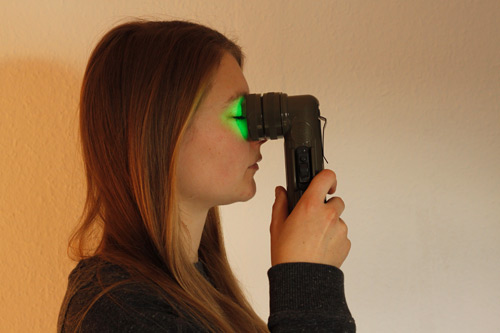
What Can You Treat With Colored Light?
The premiere textbook for Spectro-Chrome is "Let There Be Light," written by one of Dinshah's sons, Darius Dinshah, current president of the Dinshah Health Society. This book lists more than 320 different disorders that have been successfully treated with this method. Don't look for this on Amazon, the best place to get a copy is on Dinshahhealth.org.Wunsch goes so far as to say he would not exclude any disorder from the potential treatment with colored light, because you can, at bare minimum, benefit from symptomatic treatment. That said, one concrete example includes the treatment of skin burns.
"[Dinshah] understood green as the central color … the color which balances all the different body functions, mental functions and partly also emotional functions. The colors with longer wavelengths compared to the green, he called the infragreen colors. The shorter wavelengths, he called the ultragreen colors …
[W]hen you think of the classical signs of inflammation … you have the reddening, the erythema, you have heat, the inflammation. You have too much inflammatory or flame effect, so to say. The tissue gets red. The tissue gets hot. The tissue is painfully altered. You have hampered function …
Too much of red, too much of heat gives you already the idea of which color to use. You would use the ultragreen color to compensate for the long wavelengths, which become apparent by reddening, fever or heat. An acute inflammation would be treated with ultragreen colors and vice versa.
The chronic inflammation or the chronic disorder should be treated by the infragreen colors. You're always aiming to reach the green after a certain while, because this is the balance. This is the middle between the extremes."
To Cool Heat (Red) Symptoms, Use Violet or Indigo
This is not to say that there's not a certain level of complexity involved. For example, you need to be cautious with ultraviolet (UV) rays and shorter wavelengths when you have a wound, as exposing wounds to sunlight can result in more severe scars. Wunsch explains:"If you have inflammation … sometimes it comes along with an infection. Some germs, some bacteria, are aggravated or they benefit from shorter wavelengths. UV light can induce inflammatory reactions. We can tell this, for example, from the erythema caused by sunlight. This was one of Niels Ryberg Finsen's findings that short wavelength light acts as an inflammatory.
If you have too much heat and you want to cool it down, it's important to lower the activity of the metabolism. The metabolism is more or less represented by the activity of mitochondria. If you have an overactivity of mitochondria, then you would increase this over activity, probably, if you are using long wavelengths, because the long wavelengths definitely activate mitochondrial activity, metabolism and energy production, which we know from photobiomodulation.
So yes, you could treat a skin burn with a certain intensity of long wavelength light. This is not what Dinshah did [though]. For severe skin burn, which is induced by long wavelength, which is a thermal skin burn, he would use violet or indigo in the first phase.
The reason is when we talk about the thermal skin burn, we have blistering. We have excretion or secretion of liquid. We want to reduce these secretory activities. Here, the violet or the ultragreen colors in general are much better than the infragreen colors.
There comes a moment in the process of wound healing where we definitely need the longer wavelengths as well, where we start and compensate for the excessive heat, for the excessive infragreen. We compensate for that using the ultragreen colors.
Personally, I [had] the best experience using the indigo in the first step. If you treat a skin burn once or twice with indigo, you can even keep this injury from developing a blister … [I]f the blister does not fully form, it will hold and it will stay on the skin, even if it's thermally modified. It will stay as your own natural wound dressing for the first few days. This gives the deeper layers the time to regenerate and restore."
Practical Example: How to Treat a Burn With Colored Light
If you were to get a sunburn, or accidentally burn yourself on the stove or hot instrument, how exactly would you treat it using colored light? Wunsch recommends using a simple incandescent lamp equipped with an indigo filter. Post-surgical wounds also benefit from indigo.If you're even the least bit handy, you can easily build your own Spectro-Chrome color projector. For a mere 50 cents, you can purchase step-by-step instructions1 to make a color projector with a 25- or 40-watt reflector lamp, some cardboard and glue from the Dinshah Health Society.
The book will also tell you exactly which filters you need to get to achieve the recommended Spectro-Chrome colors. Rosco and LEE are two companies making colored filters. This book is available on Dinshahhealth.org.
A drawback with these filters is that since they're made for theater lighting, they also transmit white light. In other words, they're not as saturated as the true, original Spectra-Chrome filters were. To achieve the required saturation, you'll need to combine two or more filters according to the recommendations of the Dinshah Health Society (detailed in "Let There Be Light").
As for the lamp, Wunsch builds his using a military angled flashlight, available from Amazon. They're specifically made for adding filters for signaling purposes. Once you've made your projector, simply shine the light onto the affected area.
"The first one, two or three days, depending on the reddishness, on the heat in the tissue, you start with Indigo and [then] switch over to blue … In the classical and original Spectro-Chrome method, you would treat for 30 to 60 minutes …
[A] 10th of a millimeter under the skin surface [is] the capillary layer. All the colors of the rainbow reach the capillary layer. They reach the bloodstream. This is one of the direct actions. If you shine colored light onto the surface of the skin, it will automatically come in contact or it will automatically reach the bloodstream.
This is the reason why Dinshah recommended treatment duration of 30 to 60 minutes. He wanted to make sure that your whole blood comes in contact with the treatment color several times during the treatment session … Personally, from my own experience, after five minutes of treatment of thermal skin burn, the pain turns into a kind of tickling discomfort.
When you remove the indigo light, after 10 minutes or so, this tickling discomfort disappears almost immediately. But as soon as you treat it again or tonate — tonation [means] the use of colored light — if you go on treating it and the tickle and discomfort reoccurs, there is still [more healing to be done] …
In my experience, as long as the tickling and discomfort reappears under the influence of the indigo light, you should go on with the treatment. I had a third and fourth degree skin burn on my wrist. I treated this for more than two hours. I was able to prevent it from blistering. It healed up within two weeks or so.
After two or three days, you can use the turquoise, the green and the Lemon. Depending on the progress of healing, you adjust the color which fits to the actual condition," Wunsch explains.
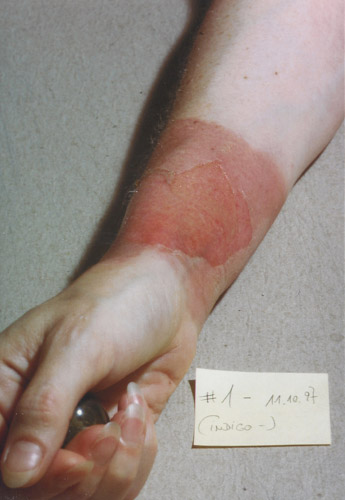
|
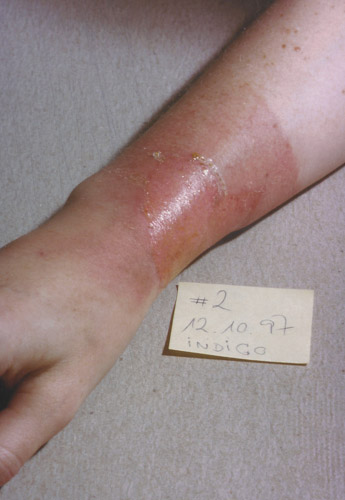
|
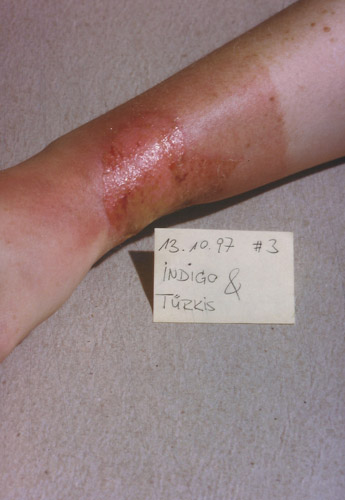
|
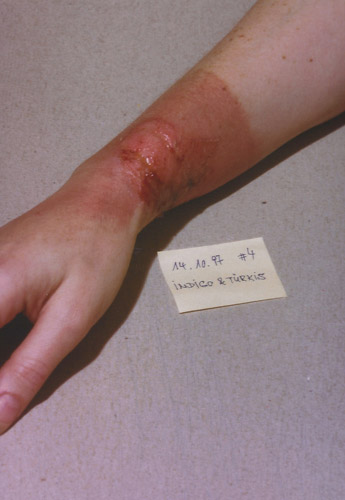
|
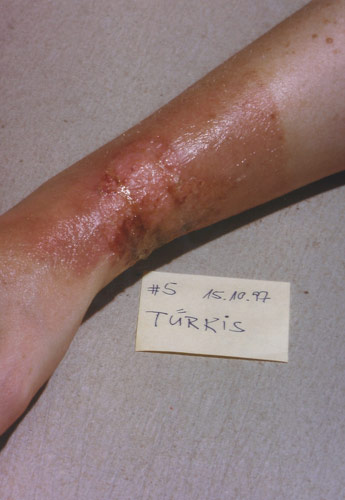
|
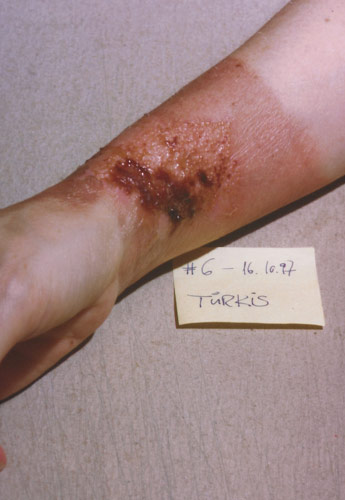
|

|

|
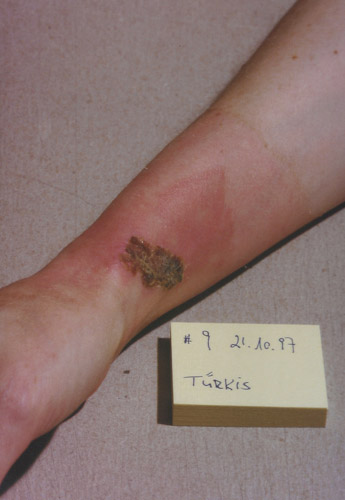
|
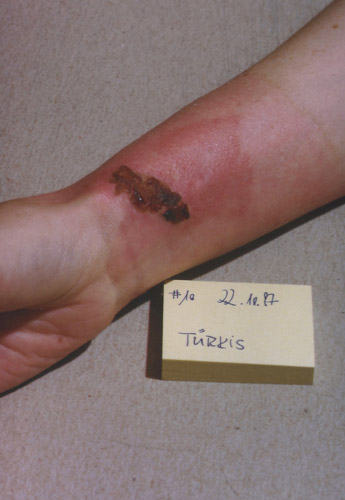
|
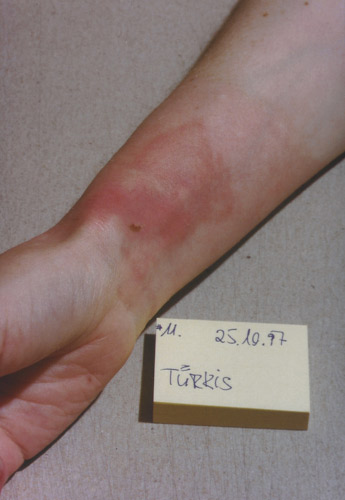
|
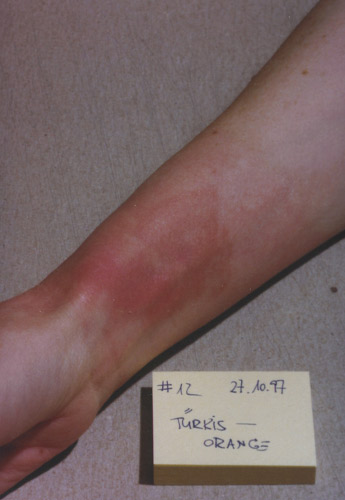
|
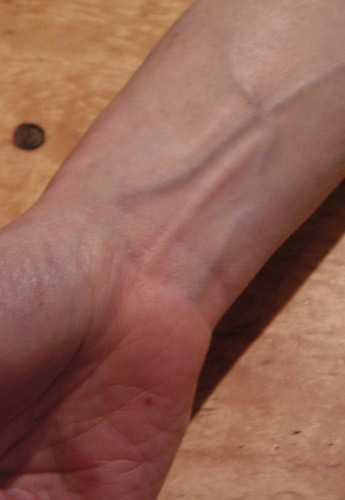
|
How Color Affects Your Skin
Contrary to the application of ice, which will only act superficially, the indigo colored light will act on different layers of your skin. Superficially, the indigo light will reduce the inflammatory reaction. In the deeper layers, there will be photobiomodulatory active radiation as well, because when you use an incandescent lamp combined with an indigo filter, you will have:- A basic field consisting of near-infrared radiation
- A controlling field, which consists of the color indigo (approximately 430 nanometers or nm), which addresses the reduction of the metabolic activity on the surface
"The filters from the old technology, you always have a transmission in the long wavelength part of the spectrum as well," Wunsch says. "This, in a way, fits well to the principle of Fritz-Albert Popp, who said there is a supporting field in the long wavelength part and an information field in the visible and probably also in the UV part.
But for the Spectro-Chrome method, we use the information part in the visible section of the spectrum, and we use the supportive energy from the wavelengths we also know as being effective in the realm of the photobiomodulation."
Treating Low Back Pain With Colored Light
Another common ailment is back pain. Wunsch, who is trained in the Alexander Technique, osteopathy, craniosacral therapy and acupuncture, notes that the area where it hurts is not necessarily the specific site of the problem. In acupuncture, specific meridian points will help alleviate back pain, but you could actually use a laser light on these points instead of a needle. You can also use temperature or vibration or other physical stimuli."Normally, the Spectro-Chrome method uses the whole body tonation. There is a set of questions you can ask, and then you will get an idea how to treat it. Is the back pain acute or is it chronic? If it's acute, you would probably use the indigo, because indigo also relieves pain. An alternative would be violet or purple. These three colors are classical pain relievers.
If it's a chronic event, you would not necessarily treat the area of pain, but you would start with whole body tonation using lemon … As a standard, if we are talking about a chronic condition, the basic color, which is always part of the treatment regimen, is lemon."
Spectro-Chrome Glasses for Day and Nighttime Use
Another alternative is to use Spectro-Chrome glasses. Similar to a color bath, the glasses will provide systemic treatment, and they're a lot easier to use than setting up a room for full-body tonation, as you need to make sure the room is pitch-dark aside from the colored light, the temperature needs to be optimal since you must be naked or near-naked, and you need a projector and all of the necessary filters."The glasses resemble a kind of ultimate life hack, because you can just choose the best color for the moment or the situation out of the box … When we just imagine the colored world that surrounded us as early humans in the step in the Savannah, in the rainforest, in the river scape, the coast landscape, the desert, the mountains, all these settings are linked to certain colors, which are predominantly active in this scene.
The seasons, they add that color characteristics to the location and to the climate. Normally, our physical and mental body expects colors from our environment. When you are in a concrete desert and you look around, especially during the day when daylight is on, you would miss a lot of these colors. During the night, you will not have colors for longer periods of time …
I would not recommend for someone who is in a chronobiologically disordered situation to use the blue light or the blue glasses at nighttime … [T]here are colors that are recommended for the use during the daytime and other colors are recommended for the use during nighttime — those are the purple and magenta colors. Purple is the color which has the highest impact on sleep quality …
[P]urple activates bromine … [B]romine was used in former times … for sleep disorders. Magenta stimulates lithium and alleviates depression. It's the color addressing soul-associated disorders. Lithium salts are used for depression treatment in pharmacology as well. Instead of administering lithium, Dinshah would administer magenta. Magenta, purple, those are colors that should be used during the nighttime."
A Remarkable Success Story
A powerful testament to the effectiveness of color therapy comes from Wunsch's own family, on his wife's side. A male relative was diagnosed with liver cirrhosis at the age of 50. The university clinic gave him six months to live, telling him to go home and get his affairs in order. Using Dinshah's method, he exceeded this grim forecast by a factor of 72."He traveled from Germany to Dinshah's place [in Malaga] and learned all about the diligent use of the Spectro-Chrome method from Dinshah. He took a set of filters home and started to treat himself as you would treat a chronic condition, with lemon and red. Red is the color which addresses the liver. He was able to add another 36 years to his life."Personally, I believe chromotherapy is a safe and powerful alternative healing strategy that nearly anyone can add to their self-healing toolbox. For $100 or so you can obtain all the information and supplies you need. Just like liposomal C, which I believe should be in every emergency kit to treat acute infections, a light with an indigo or violet filter is another must to radically accelerate burn healing.
Again, you'll want to get Dinshah's book, "Let There Be Light," from the Dinshah Health Society. (It's also available on Amazon, but you'll pay as much as five times the price.) Once you know which Spectro-Chrome colors you need, you can buy the required filters from Rosco or LEE and fashion a projector, either using Dinshah's inexpensive projector plans or an angle head military flashlight. Alternatively, invest in a set of Spectro-Chrome glasses, available from Innovative Eyewear.
+ Sources and References
brilliant timeless wisdom...thanks
ReplyDelete